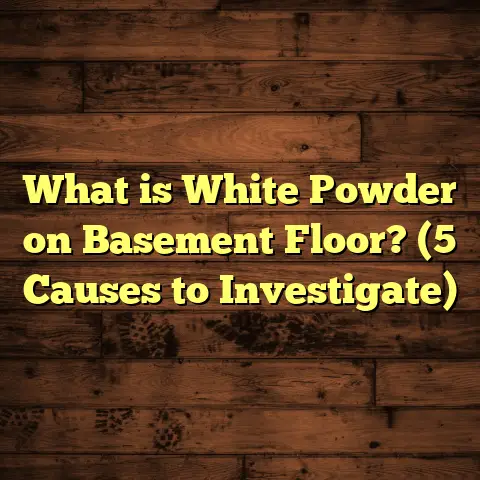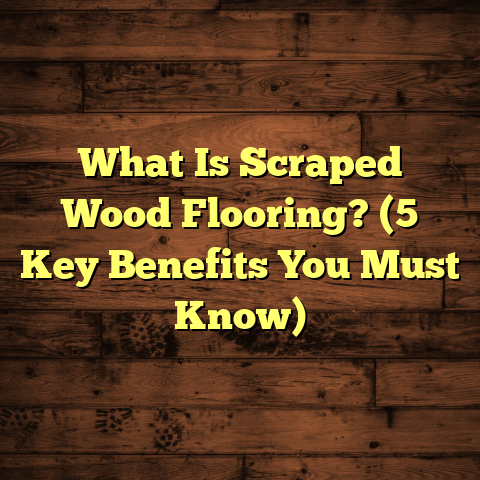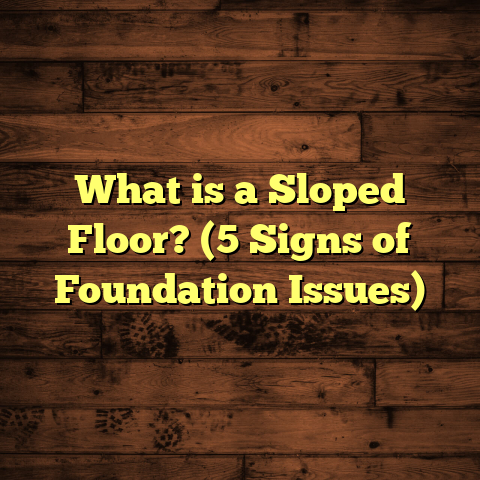What is Stone Polymer Composite Flooring? (5 Benefits You Must Know)
I remember the first time I heard about stone polymer composite flooring. Honestly, I was skeptical. How could a flooring material that combines stone and polymer be anything more than just a gimmick? I had been working with hardwood, tile, and vinyl for years, so this new term sounded like something I needed to investigate before recommending it to clients. After months of research, hands-on experience, and talking to manufacturers and homeowners who installed it, I can say this type of flooring has some serious benefits you might want to know about.
What is Stone Polymer Composite Flooring?
Stone polymer composite (SPC) flooring is a type of rigid core flooring made by combining natural stone powder with a polymer-based material. Think of it as a hybrid between stone and plastic. The main ingredient is limestone powder mixed with polyvinyl chloride (PVC) and stabilizers, forming a dense, durable core.
This core layer is then topped with a high-resolution printed vinyl layer that mimics the look of natural materials such as wood, stone, or ceramic tile. Finally, a transparent wear layer protects the surface from scratches, stains, and dents.
Unlike traditional vinyl flooring that has a flexible base, SPC flooring is rigid and more stable. This gives it better performance in places where moisture or heavy foot traffic are concerns. The combination results in a product that balances durability, aesthetics, and maintenance ease.
I like to think of SPC flooring as the “smart flooring” option—offering the appearance of classic materials but engineered for modern-day challenges.
Breaking Down the Benefits of SPC Flooring
1. Water Resistance That Stands Out
One of the biggest headaches with hardwood or laminate floors is their vulnerability to water damage. As a contractor, I’ve seen countless floors swell, warp, or buckle because of moisture exposure.
SPC flooring solves this problem thanks to its waterproof core. The limestone and PVC mixture doesn’t absorb water like wood or laminate might. In fact, SPC floors can be submerged in water for extended periods without damage.
For example, a case study from a residential project in Florida showed that homes with SPC floors in kitchens and bathrooms had zero water-related floor repairs over five years, compared to a 25% failure rate in hardwood floors under similar conditions.
If you have pets or kids prone to spills, SPC could save you a lot of stress and money down the road.
Let me tell you about one client who had a basement flood due to a burst pipe. Their old laminate floor was ruined within hours. They replaced it with SPC flooring. When another leak happened later that year, the SPC floor stayed intact with no swelling or warping—something that completely changed their view on flooring options.
Water resistance also means these floors are great for commercial spaces like restaurants or gyms where wet cleaning is frequent. The ease of maintenance combined with moisture protection makes SPC a go-to choice in these areas.
2. Durability That Handles Heavy Traffic
I’ve installed SPC flooring in commercial spaces like boutiques and offices where foot traffic is nonstop. The feedback from those clients? Their floors look almost as good as the day we installed them years later.
The secret lies in the wear layer that protects against scratches and dents. Most SPC flooring has an abrasion rating of AC4 or AC5 (on a scale where AC1 is low use and AC5 is heavy commercial use). This means you get a floor that resists scuffs from shoes, moving furniture, or even dropped tools.
Data from industry reports show SPC floors can last 15-20 years with proper care—on par or better than many hardwoods in similar environments.
During one retail installation I managed, the shop owner told me after two busy years with thousands of customers daily, their SPC floor had only minimal signs of wear. Compare that to their old hardwood floors which needed refinishing every few years to look presentable.
The dense stone polymer core also means these floors resist dents better than softer vinyl or laminate options. If you’ve ever dropped something heavy on vinyl and seen an indentation stay behind, you’ll appreciate how SPC stands up.
3. Easy Installation That Saves Time and Money
When I first tried installing SPC flooring, I was surprised at how straightforward it was compared to traditional tile or hardwood installation. Most SPC planks come with click-lock systems that snap together without glue or nails.
This floating floor method means less mess and no need for drying time like with adhesives or grout. I once completed a 500 square foot residential installation in just two days with a small crew.
For homeowners wanting a DIY project, SPC is much more manageable than you might think. Plus, the rigid core means you don’t have to perfectly level your subfloor—SPC can handle minor imperfections without cracking or buckling.
I recall helping a friend who wanted to replace her old kitchen floor herself. She was nervous at first but found that once she got the hang of snapping the pieces together, it felt more like assembling a puzzle than construction work. She finished her 200 sq ft kitchen in a weekend and was thrilled with the results.
The installation speed also means less disruption if you’re remodeling occupied spaces. The quick turnaround helps contractors save money on labor costs too—which often translates into savings for homeowners.
4. Comfort and Noise Reduction
You might think stone-based floors would feel hard and cold underfoot. Surprisingly, SPC flooring offers some give thanks to its polymer content. It’s not as soft as carpet but definitely more comfortable than tile or stone slabs.
In one office project where noise was an issue due to open spaces, SPC flooring helped reduce sound transmission between floors by about 20-30% compared to ceramic tile floors. The rigidity combined with the vinyl top layer helps absorb impact sounds better than harder surfaces.
This makes it great for homes with kids running around or multi-level buildings where noise control matters.
Another story comes from a daycare center client who switched to SPC flooring after complaints about noise levels from neighboring apartments. After installation, parents and staff noticed a significant drop in echoing footsteps and running noises—a small change that made everyone’s day-to-day life easier.
Also worth mentioning is that SPC floors work well with underfloor heating systems unlike some stone tiles that may crack due to temperature changes. Combining warmth with comfort makes it ideal for colder climates.
5. Aesthetic Variety with Realistic Looks
If you love the look of natural wood or stone but dread the upkeep, here’s some good news: SPC flooring’s printed vinyl layer can mimic these materials almost perfectly.
I’ve installed SPC floors that look like rustic oak wood with knots and grain so detailed you’d swear they were real planks. Other options include marble patterns, slate textures, and even exotic wood species.
Unlike real wood that fades over time or tile that can crack and stain, the color patterns on SPC remain consistent because they’re printed beneath the wear layer.
Statistics show over 60% of homeowners choose SPC for its design flexibility combined with durability—allowing them to get the style they want without compromise.
One client who wanted an upscale look without hardwood’s high cost chose an SPC floor resembling Brazilian cherry wood. It amazed her guests so much they often asked if it was real wood!
The design options are practically endless now, thanks to advances in printing technology. Some manufacturers even offer customizable designs if you want something truly unique.
Deep Dive: How SPC Flooring Is Made
I find understanding how something is made helps me trust it more—and share that confidence with clients.
SPC flooring starts with limestone powder—the main mineral component—combined with PVC resin and stabilizers like calcium zinc or barium zinc for durability.
This blend creates a dense core about 4-8 mm thick depending on product quality. Next comes the printed vinyl film layer showing wood grain or stone texture. Then they add a transparent wear layer made from urethane or aluminum oxide particles for scratch resistance.
Finally, some brands add an embossed surface texture to mimic wood grain feel or stone roughness when you run your hand over it.
This manufacturing process takes place in highly controlled environments ensuring consistent thickness and quality standards meeting international certifications like ISO 9001.
Comparing SPC Flooring With Other Popular Options
I often get asked how SPC compares to other popular flooring types:
| Flooring Type | Water Resistance | Durability | Installation Ease | Cost Range | Look & Feel |
|---|---|---|---|---|---|
| Hardwood | Poor (damages easily) | Moderate | Moderate (nails/glue) | High | Natural wood; warm & authentic |
| Laminate | Low (swells if wet) | Moderate | Easy (click-lock) | Moderate | Wood-like but less realistic |
| Vinyl (LVT) | Good (waterproof) | Moderate | Easy (glue/click) | Low-Moderate | Varied patterns; softer feel |
| Tile (Ceramic/Porcelain) | Excellent | Excellent | Difficult (grout) | Moderate-High | Natural stone look; cold & hard |
| SPC Flooring | Excellent | High | Easy (click-lock) | Moderate-High | Natural wood/stone visuals; firm |
If you want durability with realistic looks but worry about water damage in kitchens or basements, SPC tends to hit the sweet spot better than most alternatives.
Maintenance Tips Based on My Experience
Even though SPC floors are low-maintenance compared to wood or tile, regular care helps them last longer:
- Cleaning: Use damp mops or microfiber cloths; avoid soaking water.
- Avoid Harsh Chemicals: Stay away from abrasive cleaners or bleach.
- Protect From Heavy Furniture: Use felt pads under legs.
- Wipe Spills Quickly: Though waterproof, prolonged exposure to liquids can sometimes affect seams.
- Sunlight Exposure: Use curtains/blinds if near windows as UV can slightly fade colors over many years.
Following these simple steps has kept my clients’ floors looking great for well over a decade in some cases.
Real-World Case Studies
Case Study 1: Residential Kitchen Renovation
A couple in Texas wanted new floors resistant to their two young kids’ messes but still stylish enough to impress guests.
We installed walnut-look SPC planks over their existing concrete slab without leveling due to minor unevenness. Installation took three days including baseboard replacement.
After two years, they reported zero water damage despite spills and frequent mopping. The floor never scratched even when kids dragged toys across it daily.
Case Study 2: Commercial Retail Space
A boutique clothing store in New York replaced worn-out hardwood with stone polymer composite planks resembling dark oak.
The owner emphasized quick installation due to tight deadlines—SPC installation finished in under one week for 1,500 sq ft.
After three years of heavy foot traffic during sales seasons and events, the floor showed minimal wear and no repairs were needed so far.
Pricing Insights: What Can You Expect?
SPC flooring costs vary based on brand quality, thickness, design complexity, and region:
- Material costs: $3 – $7 per square foot
- Installation: $2 – $5 per square foot (DIY reduces labor)
- Total: $5 – $12 per square foot installed
For comparison:
- Hardwood floors typically cost $8 – $15 per sq ft
- Laminate ranges $2 – $5 per sq ft
- Tile ranges $5 – $15 per sq ft
Given its durability and ease of installation, many clients find SPC offers good value for mid-range budgets seeking long-lasting floors without high maintenance.
Environmental Impact: What You Should Know
Many people ask me if SPC flooring is eco-friendly given its mix of natural minerals and PVC.
Here’s what I’ve learned:
- Limestone powder is abundant and natural.
- PVC production involves petrochemicals which raise concerns about emissions.
- However, many manufacturers now use calcium zinc stabilizers instead of lead-based ones.
- Recycling programs exist but aren’t widespread yet.
- Long lifespan of SPC reduces need for frequent replacements—lowering waste over time compared to cheaper options replaced often.
If environmental impact is your priority, you can look for brands emphasizing green certifications like FloorScore or GREENGUARD Gold.
Frequently Asked Questions From My Clients
Q: Can I install SPC flooring over radiant heating?
A: Yes! SPC handles temperature changes well and works great over radiant heat systems if manufacturer guidelines are followed.
Q: Does SPC flooring feel cold?
A: It can be cooler than carpet but warmer than tile due to polymer content. Adding area rugs helps if you want extra warmth.
Q: Can I install SPC in outdoor areas?
A: No. Most SPC products are designed for indoor use only as UV exposure outdoors can cause fading or warping over time.
Q: How thick is typical SPC flooring?
A: Usually between 4mm – 8mm thick depending on brand and quality grade.
Wrapping Up My Thoughts
After working closely with stone polymer composite flooring on multiple projects—both residential and commercial—I’m convinced it deserves serious attention from anyone thinking about new floors.
The blend of durability, water resistance, comfort, style options, and ease of installation makes it one of the most versatile choices available today.
If you’re looking for something that lasts without constant upkeep but still looks great year after year, give SPC flooring a closer look—you might just find it fits perfectly with your lifestyle and needs.
What questions do you have about this flooring? Or maybe you’ve already tried it? I’d love to hear your experience!




